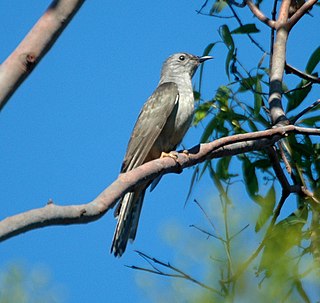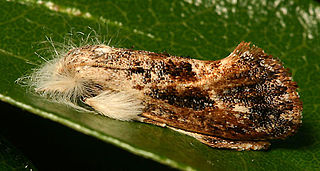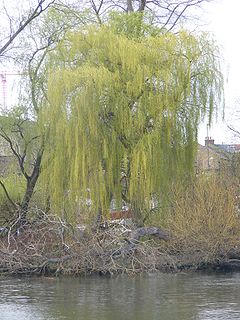
The brush cuckoo is a member of the cuckoo family.

Citheronia sepulcralis, the pine-devil moth, is a Nearctic member of the family Saturniidae and of the subfamily Ceratocampinae. The species are blackish brown. The species was first described by Augustus Radcliffe Grote and Coleman Townsend Robinson in 1865.

Acrolophus is a genus of moths in the family Acrolophidae, with, typically, great individual variation within species in color pattern, making field identification of many individuals difficult or impossible. It was described by Felipe Poey in 1832.

Salix × sepulcralis 'Chrysocoma', or Weeping Golden Willow, is the most popular and widely grown weeping tree in the warm temperate regions of the world. It is an artificial hybrid between S. alba 'Vitellina' and S. babylonica. The first parent provides the frost hardiness and the golden shoots and the second parent the strong weeping habit.
This cross was originally made at the Späth Nursery and was first mentioned in their 1888 nursery catalogue as S. vitellina pendula nova.
Being a cultivar from the Chrysocoma Group, which includes all crosses between S. alba and S. babylonica, it is much hardier and more long-lived than the Babylon Willow. This particular cultivar is easily distinguished from the other Golden Weeping Willow by its androgynous catkins.

Acrolophus popeanella is a moth of the family Acrolophidae. It is found in the eastern United States, from New Jersey and Ohio south to Florida and west to Illinois, Nebraska and Texas.
Acrolophus fervidus is a moth of the family Acrolophidae described by August Busck in 1912. It is found in Costa Rica, Mexico and Texas.

Acrolophus arcanella is a moth of the family Acrolophidae. It is found in eastern North America.

Acrolophus texanella is a moth of the family Acrolophidae. It is found from Maryland to Florida and to Texas.
Acrolophus basistriatus is a moth of the family Acrolophidae. It is found on Cuba.
Acrolophus macrogaster is a moth of the family Acrolophidae. It is found in North America, including Arizona.
Acrolophus propinqua is a moth of the family Acrolophidae. It is found in North America, including Alabama, Florida, Georgia, Illinois, Louisiana, Maryland, Mississippi, New York, Ohio, South Carolina, Tennessee, Virginia and West Virginia.
Acrolophus echinon is a moth of the family Acrolophidae. It is found in Mexico.
Acrolophus galeata is a moth of the family Acrolophidae. It is found in South America.
Acrolophus harparsen is a moth of the family Acrolophidae. It is found in Puerto Rico.
Acrolophus mimasalis is a moth of the family Acrolophidae. It is found in the West Indies.
Acrolophus noctuina is a moth of the family Acrolophidae. It is found in the West Indies.
Acrolophus ornata is a moth of the family Acrolophidae. It is found in Colombia.
Acrolophus pusilla is a moth of the family Acrolophidae. It is found in Colombia.
Acrolophus walsinghami is a moth of the family Acrolophidae. It is found in Puerto Rico.

Eucalyptus sepulcralis, commonly known as weeping gum or weeping mallee, is a mallee that is endemic to a small area along the southern coast of Western Australia. It has slender stems with smooth bark, narrow elliptical to narrow lance-shaped leaves, flower buds in groups of seven, pale yellow flowers and barrel-shaped to urn-shaped fruit.







